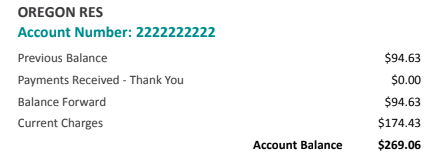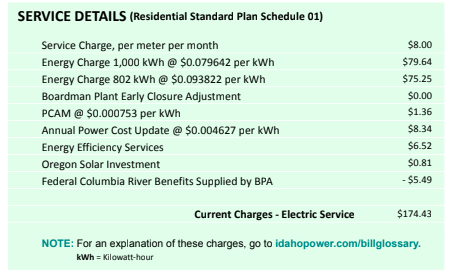Utilities 101: How to Read Your Idaho Power Bill
Posted on September 14, 2021 by Charlotte Shuff
Tags, Oregon Utilities 101, Energy

For many customers, understanding what goes into your monthly energy bill can be confusing. In this blog series, we will discuss how to understand your energy bill. This guide is for customers of Idaho Power who have standard bills. If you have opted into Budget Pay or Time of Use billing programs, your bill may look a little different.
Not an Idaho Power customer? Check out our bill guides for Portland General Electric and Pacific Power customers. Stay tuned for guides on Oregon’s other major energy utilities coming to the CUB Blog soon!
How to View Your Idaho Power Bill
Many Idaho Power customers receive physical bills in the mail. If you are one of these, viewing your bill is as easy as opening an envelope.
If you receive your bill electronically, you can access your bill by logging into your Idaho Power account online at idahopower.com/myaccount. Even if you receive your bill in the mail, you will also be able to view it online.
Anatomy of an Idaho Power Bill
Page 1: Your Account and Billing Information
The first section of your bill shows the charges from last month and new charges. Many customers may just want to know how much their bill is for the month.

The Previous Balance is the amount charged on your last bill. You can see how much you paid on your last bill in the Payments Received section. Anything that was not paid on previous bills will carry over in the Balance Forward line. The Current Charges section is the new amount for the current bill. The Account Balance is what is owed on the current bill, including any outstanding charges from past months. The due date for this bill and the total amount due is found on the top right corner of the bill.
You can also view how much energy your home has used over the past year broken down by month in the Average Daily Energy Use graph. It’s normal to see higher energy use in the winter and summer months when you’re more likely to use heating and cooling systems. For measuring energy use, the amount of electricity you used will be measured in kilowatt hours (kWh). A typical Idaho Power household uses about 1100 kWh of electricity per month, though amounts vary between households.
Page 2: Account Details
Your account details on the second page are a general overview of your account, as well as more information on your energy use for this billing cycle.

At the top of this section, you can see your meter number. Your meter is the device that tracks the amount of electricity you use at home. Idaho Power looks at your meter each month, either remotely or in person, and tracks the meter reading numbers to determine how much energy to bill you for. You can see the electricity you used this month in the Energy Used section. This will be the same as the difference between the current and previous meter readings.
Page 2 (continued): Service Details
If you want to look more deeply into the charges on your bill, a good place to start is the Service Details section.

The schedule, or rate schedule, is specific to different types of customers. The schedule for residential customers is Schedule 01. Rate schedules lay out the prices utilities charge per unit (kwh) of electricity for a given household.
These individual line items vary depending on where you live, the type of billing you use, and if you have opted into additional programs. You can tell where you are receiving a credit if the line item has a minus sign (-) to the left of the dollar amount.
Basic charges include:
- Service Charge: Same amount each month ($8.00 for most residential customers), covers administrative costs like customer service and billing, and fixed costs like the cost of the meter. Most homes have “single phase” power, which describes how your home connects to the power grid.
- Energy Charge: The cost of Idaho Power’s generating electricity, including gas plants and renewable investments. For residential customers, there are two tiers of monthly energy use charges: 7.96 cents for the first 1,000kWh (what most residential customers pay) and 9.38 cents for anything over 1,000kWh.
- Boardman Plant Early Closure Adjustment: This charge goes to the cost of closing the Boardman Coal Plant early. The plant closed in late 2020.
- PCAM: The Power Cost Adjustment Mechanism (PCAM) can be either a credit or charge depending on the year. If the cost of power for the past year was much lower than expected, customers get a credit. If the cost of power was much higher than expected, customers will see a charge.
- Annual Power Cost Update: This charge covers expected costs for generating electricity and is updated each year. This rate charge covers the costs of generating power using natural gas, coal, purchased electricity, hydroelectric power, geothermal power, solar, and wind power.
- Energy Efficiency Services: This standard charge funds energy conservation measures, like energy efficiency or other cost-effective tools to reduce energy use.
- Oregon Solar Investment: All Oregon residential customers of Idaho Power receive this charge, which goes to funding investments in solar (photovoltaic) pilot programs required by law.
- Federal Columbia River Benefits: The Bonneville Power Administration (BPA) credit is applied to qualifying customers for all usage below 1,000 kwh each month to help with the cost of investing in hydroelectric resources.
Still have questions about understanding your bill? Call Idaho Power’s customer service at 1-800-488-6151. Or contact CUB at .(JavaScript must be enabled to view this email address) or 503-227-1984 ext. 1.
To keep up with CUB, like us on Facebook and follow us on Twitter!






10/05/22 | 0 Comments | Utilities 101: How to Read Your Idaho Power Bill